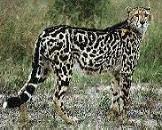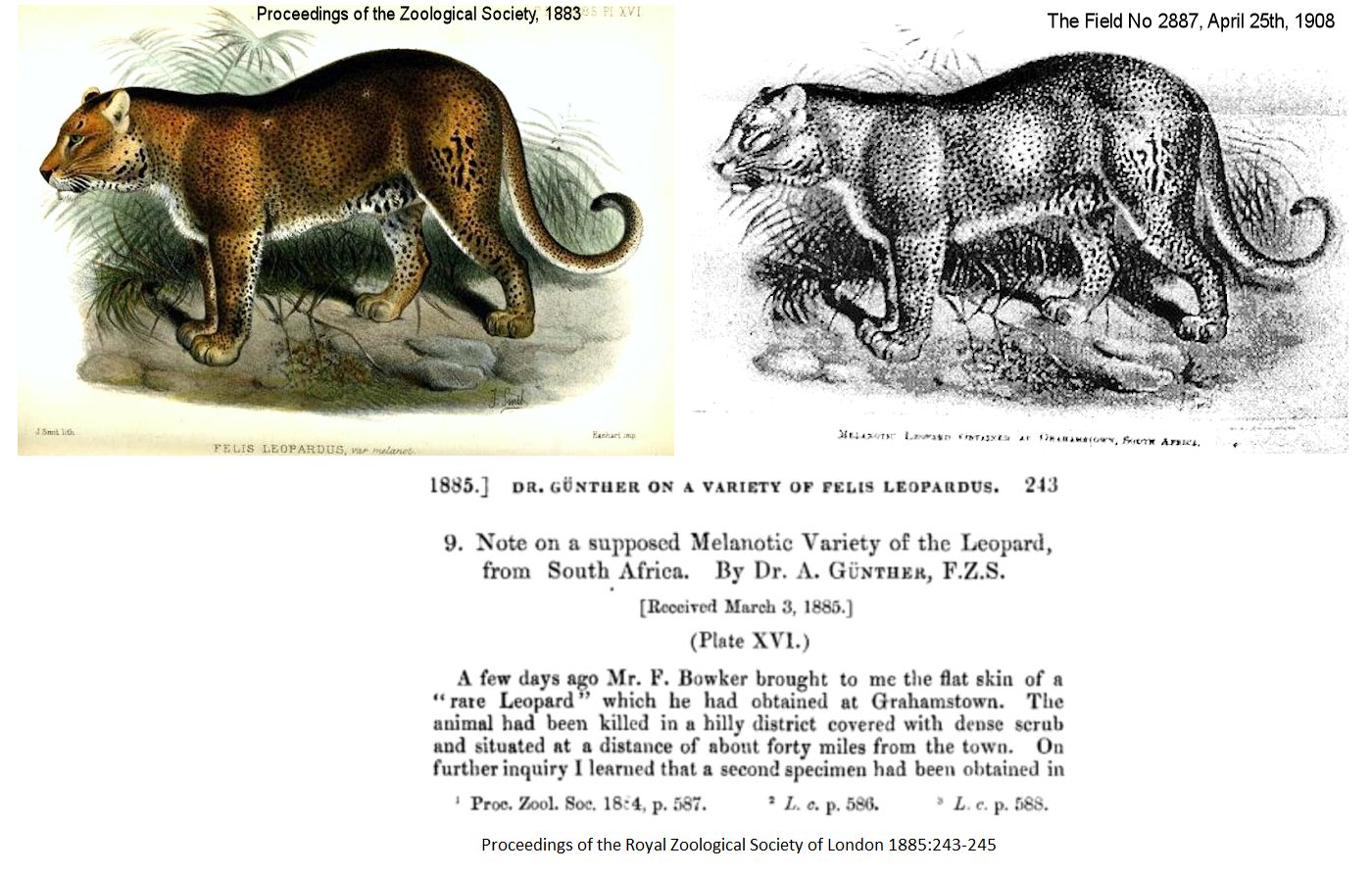
King cheeth, once posited as a leopard x cheetah hybrid
|
CHEETAH HYBRIDS |
CHEETAH /LEOPARD HYBRIDS (CHEETAPARD)
The Cheetah (Asia/Africa) is neither a "big cat" nor a "small cat" but usually is placed in a family of its own. There are probably only two subspecies - the African and the Asian. Archaic forms of cheetah were more widespread, including long extinct North American varieties.
There is some fascination over whether cheetahs and leopards could hybridize and produce offspring, in particular the possibility of a black leopard (panther) x cheetah hybrid to give a black cheetah.. In the wild, cheetahs (diurnal) and leopards (nocturnal) occupy the same territory but avoid conflict by having different activity patterns. Leopards will attack cheetahs. Over the years there have been sporadic reports of a "cheetapard" (or cheetard) or "forest cheetah", a creature built like a cheetah but marked like a leopard. Some early reports suggested it was a forest-dwelling hybrid between the cheetah (a plains dweller which runs down prey) and the leopard (an excellent tree-climber and ambush hunter). The blotched King Cheetah was once thought to be evidence of a cheetah/leopard hybrid since East African legends claim that leopards will sometimes mate with cheetahs. The King Cheetah is a naturally occurring colour variety of the cheetah. Instead of small, discrete spots, the king cheetah is marked with swirls and blotches much like a tabby domestic cat. At first regarded as a hybrid, it was later thought to be a new species of forest-dwelling cheetah and is now known to be a colour variation. Normal spotted and mutant blotched cheetah cubs can occur in the same litter.

King cheeth, once posited as a leopard x cheetah hybrid |
In captivity, the two animals could be reared together and a mating arranged. Some sources claim the cats are genetically similar enough to produce hybrids, others state the exact opposite citing the cheetah's extremely specialised form as a barrier to producing viable foetuses. The two species have similar gestation periods. Cheetah hybrids are unlikely for other reasons. The lightweight size and build of the cheetah means that a female cheetah is unlikely to carry large hybrid cubs to term or might be unable to deliver them if she did. Severe inbreeding has resulted in very poor sperm quality (below what is normally the threshold of infertility) so cheetah sperm might be unable to fertilize the eggs of another big cat species. Growth dysplasia would also be likely. Cheetah females are often mated by a coalition (bachelor group) of males while leopard females generally have a single mate. If this is the case, it would be comparable to the growth dysplasias seen in ligers and tigons.

Pseudo-melanistic leopard, once posited as a leopard x cheetah hybrid (The Field, 1908) |
Theoretical leopard (panther) x cheetah hybrids would have a mix of leopard and cheetah characteristics - a spotted or rosetted pelt (leopard melanism is recessive), semi-muscular build intermediate between the stocky leopard and the rangy cheetah. A hybrid would be stockier than a cheetah, but less stocky than a leopard and would therefore lack the running speed of a purebred cheetah.
In January 2003, India announced plans to clone Iranian Asiatic cheetahs, a species now extinct in India and limited to only about 50 cheetahs in Iran. Scientists at Hyberabad's Centre for Cellular and Molecular Biology, says scientists will use surrogate leopard mothers to carry the cloned cheetah cubs. The clones will not be leopard-cheetah hybrids, they will be pure cheetahs. The fact that their mitochondrial DNA is likely to be from the leopard egg cell does not make them hybrids.
CHEETAH/JAGUAR HYBRIDS
Cheetahs occur in Africa; jaguars occur in South America. In captivity, they could in theory be reared together and a mating arranged. Should such a pairing produce offspring (see above), they would be similar to a cheetah/leopard hybrid but with a different spotting pattern.
CHEETAH/PUMA HYBRIDS
The cheetah's closest relative is the Puma (America). The two species could only meet in a zoo or menagerie and I have found no reported attempts to breed cheetah/puma hybrids. Cryptozoologists once thought the North American "Onza" (a long-legged form of puma) might be a non-spotted relict form of American cheetah.
SERVEETAH
A serval/cheetah hybrid has been posited. Although both are long-legged cats, the size difference would probably prevent a mating.
CHEETAH/DOMESTIC
In October 2009, the PeoplePets website falsely reported that Chinese-born actress Bai Ling's cat Quiji was a cheetah hybrid with a cheetah father and domestic cat mother and purchased from a breeder for approximately $30,000. This is either a mistake or an attempt to mislead. The size disparity means domestic cats and cheetahs cannot form hybrids: their relative sizes make the cat a snack, not a mate and even if artifical means were used (very unreliable in felids) the gestational mismatch would be too great (cheetah gestation period is 93 days, domestic cat gestation period is around 63 days). Bai Ling's cat is not a cheetah hybrid.
On her own blog Bai in September 2008, Bai Ling stated her cat is an A1 Supreme and part-serval. Although she says the A1 Supreme is not a Savannah cat, the term "A1 Supreme" just refers to the "supreme" quality of that particular Savannah cat and the corresponding high price. A1 Savannahs apparently used photos of Bai Ling and her A1 Savannah in their adverts. Claiming it is part cheetah appears to be a publicity stunt by the actress.
REFERENCES AND FURTHER READING
For more information on the genetics of colour and pattern:
Robinson's Genetics for Cat Breeders & Veterinarians 4th Ed (the current version)
For more information on genetics, inheritance and gene pools see:
The Pros and Cons of Inbreeding
The Pros and Cons of Cloning
Textual content is licensed under the GFDL.
Many thanks to Paul McCarthy for tirelessly researching back issues of The Field and The Times
|
BACK TO HYBRID & MUTANT BIG CATS INDEX |